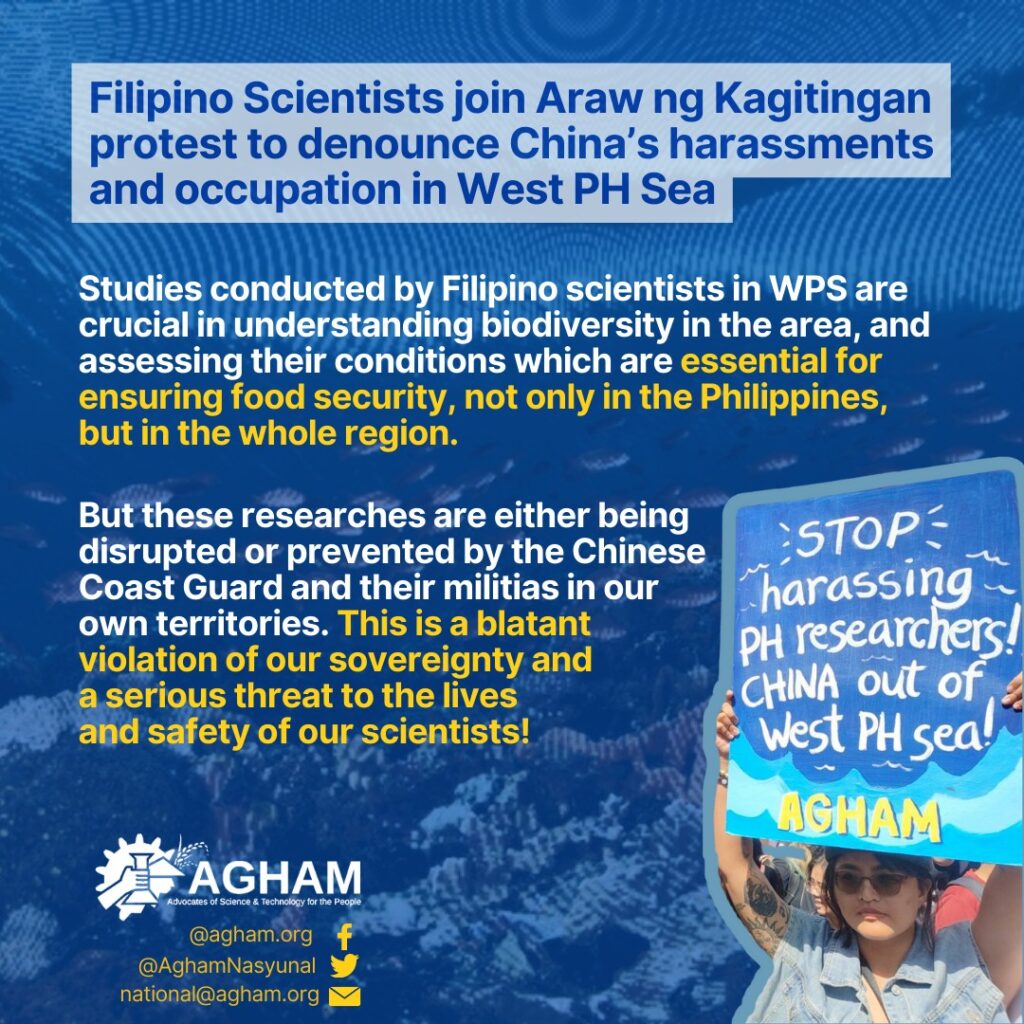Activist scientist group AGHAM Advocates of Science and Technology for the People joined the protest action in front of the Chinese Embassy in Makati to condemn the territorial incursion and relentless harassment of Chinese military forces in the West Philippine Sea. Last month, a series of violations was committed by the Chinese Coast Guard and its maritime militia in territorial waters inside the Philippine exclusive economic zone (EEZ), which includes harassment of researchers conducting studies on Sandy Cay, followed by reckless use of water cannon on a Philippine resupply vessel which caused injuries to the crews and heavy damages to the vessel.

Jenna Rodriquez, Public Information Officer of AGHAM, explained that the West Philippine Sea is renowned for its abundant marine resources, including diverse ecosystems, valuable fisheries, and extensive coral reefs. “Studies conducted by Filipino scientists in WPS are crucial in understanding biodiversity in the area, and assessing their conditions which are essential for ensuring food security, not only in the Philippines, but in the whole region”, said Rodriguez. “But these researches are either being disrupted or prevented by the Chinese Coast Guard and their militias in our own territories. This is a blatant violation of our sovereignty and a serious threat to the lives and safety of our scientists” she added.
Rodriquez further reiterated that “the biggest bully in WPS is the Chinese military. Filipinos together with Southeast Asians affected by these illegal incursions continue to denounce the disrespectful and aggressive actions of the Chinese government and its military. China’s assertion of its fictitious 10-dash line[1] is nothing but an on-going incursion, occupation, and intent to invade the territorial waters of Southeast Asian countries like the Philippines, Taiwan, Vietnam, Malaysia, Brunei, and Indonesia. It violates the sovereignty and territorial rights of these nations.”

Despite the resounding victory of the Philippines in 2016 in the UN Convention on the Law of the Sea’s arbitration ruling invalidating China’s territorial claims in the South China Sea, China has persistently bolstered its military presence by occupying atolls and small islands, converting them into military bases. Prior to the 2016 ruling, China had already constructed artificial islands, harvested giant clams and destroyed at least 8,573 hectares of coral reefs to date[2]. In 2021, AGHAM estimated that the Philippines is losing 1.3T pesos annually due to widespread ecosystem destruction caused by Chinese aggression[3].
In their statement, AGHAM demanded that “the Philippine government should persistently call for China’s withdrawal from the country’s EEZ in accordance with the 2016 UN arbitration ruling, and halt the militarization of the WPS”. This action of China in the WPS is attracting other imperialist interest in the region, as if vultures trying to take their own piece of the regional meat. In recent years, the US and its allies such as Japan and Australia have been intensifying their military activities and exercises in the South China Sea.
Rodriguez argued that “the escalation of military presence, including China’s construction of military bases and US military exercises in the region, only heightens tensions and raises the risk of potential military conflict.” The group also advocated for “a regional agreement designating the entire South China Sea and WPS as a marine protected peace and biodiversity zone, dedicated for research, fishing and mutual cooperation without undermining sovereignty, and respecting the rule of law”.
Rodriguez explained that, “while China callously turns itself into an imperialist country who bullies and dominates its Asian neighbors by its military might, the Philippines should strongly counter by steadfastly asserting our sovereignty through diplomacy and using international solidarity in opposing the incursion and bullying of China in WPS. Atin ang Pinas, dapat lumayas ang China at mga dayuhang militar sa ating teritoryo”, she ended.
SOURCES:
[1] Reuters. (2023, August 31). Philippines, Taiwan, Malaysia reject China’s latest South China Sea map. Reuters.com. https://www.reuters.com/world/asia-pacific/philippines-taiwan-malaysia-reject-chinas-latest-south-china-sea-map-2023-08-31/
[2] Kessler, R. (2024, April 8). Island-building and overfishing wreak destruction of South China Sea reefs. Mongabay Environmental News. https://news.mongabay.com/2024/04/island-building-and-overfishing-wreak-destruction-of-south-china-sea-reefs/
[3] Willard Cheng, ABS-CBN News. (2024, January 1). PH losing P1.3-t annually over destroyed coral reefs in West PH Sea, says scientists’ group. ABS-CBN News. https://news.abs-cbn.com/news/04/21/21/p13-trillion-losses-destroyed-coral-reefs-west-ph-sea
0 Comments